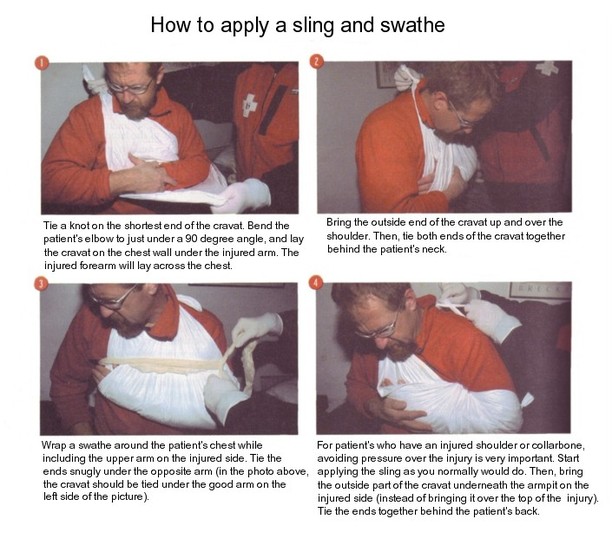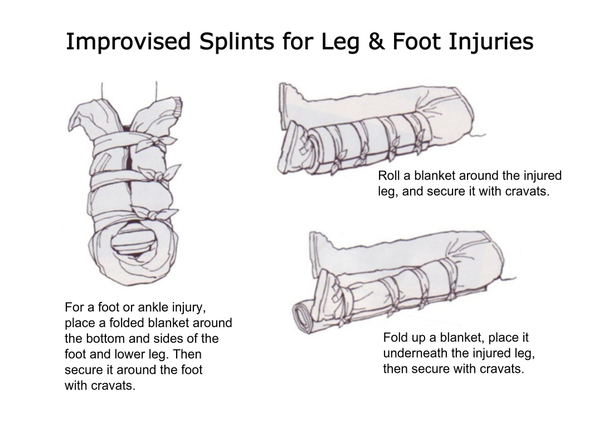Splinting Fractures, Sprains, & Dislocated Joints
How to Recognize Fractures
In most cases, broken bones will have one of the following signs or symptoms: pain at broken site, tenderness, swelling, deformity, bleeding under or through the skin. If the person can still move the wrist, joint, or stand on an injured leg or ankle, then it might be just sprained. Torn tendons and ligaments will be also be very painful even though there is no fractured bone. Treat any sprain, fracture, or torn tendons/ligaments the same way by splinting, icing, and seeking medical attention.
Upper Extremity Fractures & Sprains
See photo below for how to apply a sling and swathe to upper extremity injuries. Slings are for injuries that include wrists, arms, shoulders, and collarbones. Always fully support the broken bone until the sling is completely on (the injured person can help out with this if needed). First secure a splint to the fracture before applying the sling and swathe (the splint could be a SAM splint, padded board, or sticks taped together).
It’s important to check CMS (Circulation, Motion, and Sensation) before and after splinting. To do this, ask the injured person to move his fingers or squeeze your hand. If there was no tingling in the person's fingers before splinting, and tingling appears after splinting, then the splint may be on too tight.
Lower Extremity Injuries
See image below for how to apply a splint to lower extremity injuries out in the wilderness.
A tightly rolled blanket can be used to support a leg, foot, or ankle injury. Use cravats to secure the leg/foot to the rolled blanket. Always support the leg above and below the broken site when lifting the leg to put on a splint. Fully support the broken bone by splinting past the joints above and below the fractured site.
Improvised splints: If you do not have a blanket available out in the wilderness, sticks can be used to create a splint for leg injuries.
It’s important to check CMS (Circulation, Motion, and Sensation) before and after splinting an injury. To check CMS, ask the injured person to move his foot or wiggle his toes. Also ask if the person feels any tingling which is a sign that circulation to the injured site is not good.
Splinting Dislocated Joints
Splinting a dislocated joint is the same as treating a fracture. The only big difference is when you are splinting a dislocated shoulder. The person will not be able to move the joint, and you should NOT attempt to pop the joint back into place. Sometimes the person will feel most comfortable with the arm/elbow sticking up in the air with the hand resting on top of the head. If the arm is only sticking out a little, but mostly hanging down, then a blanket roll splint is a good choice.
Scenarios
1. A
guy is running next to a wetland when he trips on a rock and breaks his forearm.
As you are applying a sling, he starts to become nauseous and his skin is
turning cool and clammy. What do you do? Tip: First read page on signs and symptoms of shock.
2. A guy falls out of a deer stand and breaks his leg just below his knee. What do you do? What could you use as a splint if no blanket is available?
Answers:
1. Splint the broken forearm with a splint, sling, and swathe. Treat him for hypovolemic shock by keeping him warm and getting him to an emergency room fast.
2. Splint the entire leg including the foot. If no blanket is available you could tape or tie sticks together. If you do not have any tape, it would also work to tie both of his legs together to secure the broken leg from getting moved around too much.
2. A guy falls out of a deer stand and breaks his leg just below his knee. What do you do? What could you use as a splint if no blanket is available?
Answers:
1. Splint the broken forearm with a splint, sling, and swathe. Treat him for hypovolemic shock by keeping him warm and getting him to an emergency room fast.
2. Splint the entire leg including the foot. If no blanket is available you could tape or tie sticks together. If you do not have any tape, it would also work to tie both of his legs together to secure the broken leg from getting moved around too much.



